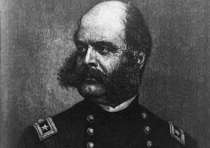
Poor timing and the intent of the Federal army to retreat once its supply trains were safely away foiled Longstreet’s double-envelopment strategy. Burnside retreated into Knoxville, and the siege was on.
The engagement at Campbell’s Station occurred as a result of Union Gen. Ambrose Burnside’s decision to delay the Confederate forces of Gen. James Longstreet moving to capture Knoxville.
Longstreet’s army of 20,000 crossed the Tennessee River at Huff’s Ferry on the night of November 13, 1863. Burnside began retreating along the line of the East Tennessee and Virginia Railroad, towards Knoxville. Longstreet, sensing an opportunity to bring his adversary to battle outside Knoxville’s fortifications, tried to catch Burnside and force him into a pitched battle.
Aggressive Confederate cavalry wreaked havoc among Burnside’s supply wagons and artillery trains. Owing to a shortage of mules, the Federals abandoned several wagons for enough mules to pull the artillery. Burnside determined to give battle long enough to allow his wagons some respite, and he deployed his forces on November 16 at Campbell’s Station to meet oncoming Confederates.
The Confederate army arrived at Campbell’s Station at about noon, advancing toward the Union positions in two lines. Federal soldiers opened up their firing at long range, but the Confederates pressed on until they were close enough to charge the Union lines, forcing the bluecoats to give way. At this point, Federal artillery opened up to check the Confederate advance.
Longstreet ordered Brig. Gen. Micah Jenkins’s division to attack the Federal left while Maj. Gen. Lafayette McLaws’s division attempted to outflank the Union right once Jenkins’s attack got underway. Jenkins’s attack stalled when his brigades had trouble keeping up with the Federals as they recoiled from Confederate artillery. The resulting confusion halted the attack as the Federals continued their retreat. Nightfall ultimately ended the engagement.
Poor timing and the intent of the Federal army to retreat once its supply trains were safely away foiled Longstreet’s double-envelopment strategy. Burnside retreated into Knoxville, and the siege was on. Federal casualties were about 400; the Confederates lost about 570 men during the engagement.
Tools
Key Facts
- Burnside hoped to delay Longstreet’s effort to capture Knoxville; Longstreet wanted to catch Burnside outside Knoxville's fortifications.
- Confederate cavalry wreaked havoc, but Burnside fought long enough to save his supply wagons and retreat.




